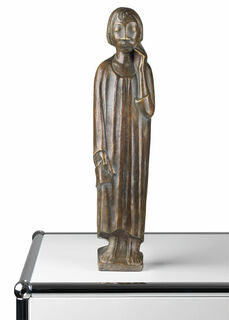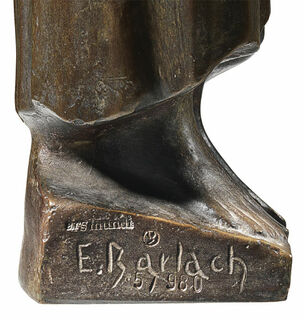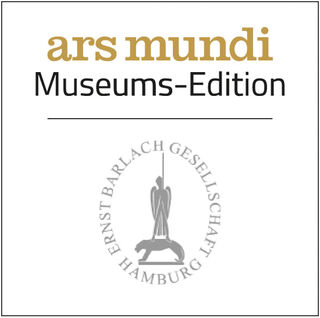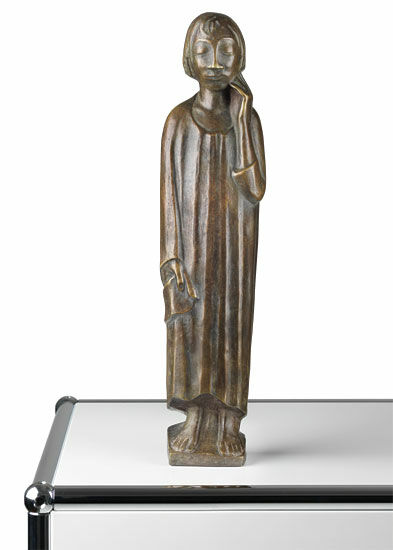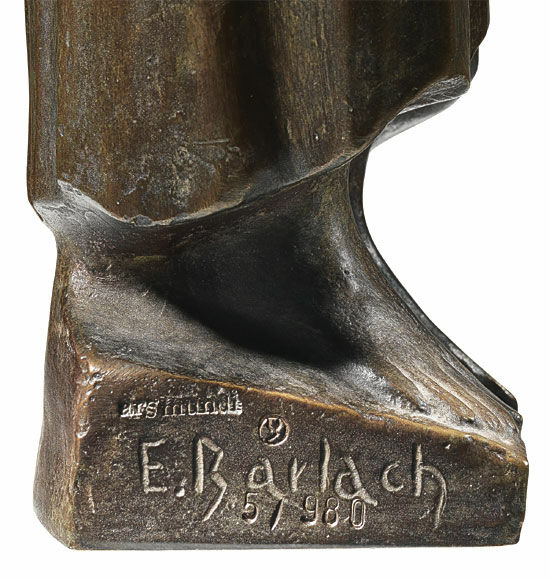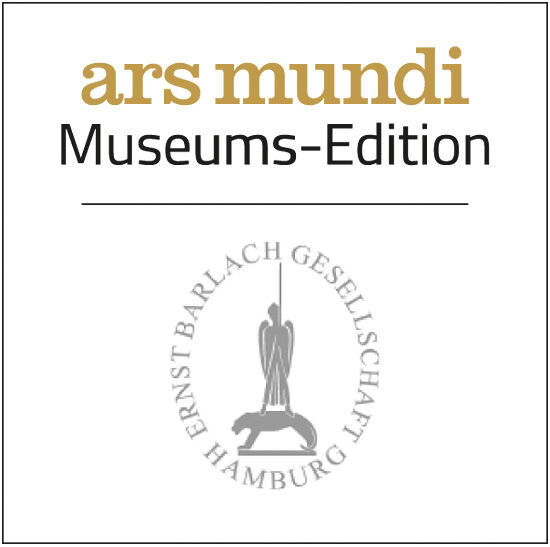Sculpture "The Pensive Man II" (1934), reduction in bronze
Sculpture "The Pensive Man II" (1934), reduction in bronze
Quick info
ars mundi Exclusive Edition | limited, 980 copies | numbered | signature | foundry hallmark | certificate | bronze | patinated | reduction | size 8 x 34.5 x 5.5 cm (w/h/d) | weight 2.5 kg
Detailed description
Sculpture "The Pensive Man II" (1934), reduction in bronze
Ernst Barlach and the work of thinking
Barlach's sculpture "Pensive Man" was created in 1934, a year of great upheaval and crucial decisions for the artist. Barlach initially testified his loyalty to the Nazi art system by signing the declaration "Call to the Artists". However, the criticism towards him and his art from the same group, the criticism that had long been voiced against him by the same group, grew to such an extent that some of his works were removed from the general public. The sculpture "Wanderer in the Wind" - which also dates from 1934 - is interpreted today as the work with which he finally took a stand against the regime. His "Pensive Man" also represents an agonising process: a young man who can see the effort of thinking because he is being asked to make a momentous decision.
Sculpture "The Pensive Man II":
Fingertips placed against the cheek and deeply absorbed in thought: Barlach's "Pensive Man" shows thinking as highly concentrated work. Cast by hand using the Lost-Wax-Process and patinated. Cast directly from the original and reduced in size (reduction). Limited edition of 980 copies, individually numbered and with the signature "E. Barlach" taken from the original as well as the foundry hallmark. ars mundi Exclusive Edition, published in cooperation with the Ernst Barlach Society. With numbered certificate of authenticity and limitation. Size 8 x 34.5 x 5.5 cm (w/h/d). Weight 2.5 kg.
"For me, 'The Pensive Man' embodies the silence of great wisdom in its posture. The slightly bulging round form of the body is only increased by the four long folds. The left hand, resting on the chin, appears as an actively raised gesture of contemplation and introspection, while the right hand is rather inactively withdrawn into the cloak. Fragile and sensitive, 'The Pensive Man' appears as the contemplative existence par excellence. He seems to be a person who is dependent on external, perhaps higher, help. He does not judge but rather bears witness solely to his existence. Spirituality and religious aura permeate the entire appearance." (Dr. Jürgen Doppelstein, Ernst Barlach Society)
Customer reviews
ich bedanke mich für die vorzügliche Abwicklung dieses Kaufes.Sowohl die überaus rasche Lieferung als auch die vertrauensvolle Rechnungslegung sind ein Beleg für die kundenorientierte und seriöse Geschäftspraxis. Übrigens: eine wunderschöne Plastik von Barlach in guter Bronze, leider kein Original.
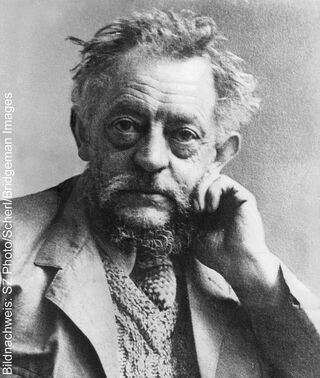
About Ernst Barlach
1870-1938, sculptor, writer and draughtsman
Ernst Barlach was born on January 2, 1870, in Wedel, Germany, and died on October 24, 1938, in Rostock, Germany. He holds an outstandingly special position within German Expressionism. As a graphic artist, draughtsman, writer and, in particular, a sculptor, Barlach created milestones in art history. Barlach's sculptural works of art have a special effect because they seek extreme experience of limits and their representation. They are works of multi-layered meaning with which he foregrounded the essence of the human being and that what stands above the self and the world.
Barlach's intention is rooted in the depths, the inner self. Shaped by war and challenging living conditions, he experiences both suffering and happiness. The human being is always the focus of his work: Ecce homo.
"I desire nothing more than to be a good and true artist as best I can. I believe that what cannot be expressed through the work can pass into the possession of another through forms. My pleasure and creative impulse continually revolve around the problems of the meaning of life and the other great mountains in the spiritual realm." (Ernst Barlach)
Ernst Barlach became an honorary member of the Academy of Fine Arts, Munich, in 1925. In 1933, he was appointed Knight of the Peace Class of the Order "Pour le mérite". In 1937, the National Socialists removed his works from public collections and spaces for being "degenerate art". Ernst Barlach died in Rostock on October 24, 1938.
Today, Ernst Barlach's works are an integral part of leading museums and collections and - if available - fetch record amounts at auction.
"The Singing Man" became Ernst Barlach's best-known sculpture, an icon of Modernism. It adorns illustrated books and posters worldwide, and the original edition is a permanent part of the collections of the world's major museums, including the Museum of Modern Art (MoMA) in New York.
An alloy of copper with other metals (especially with tin) used since ancient times.
When casting bronze, the artist usually applies the lost-wax technique which is dating back more than 5000 years. It's the best, but also the most complex method of producing sculptures.
First, the artist forms a model of his sculpture. It is embedded in a liquid silicone rubber mass. Once the material has solidified, the model is cut out. The liquid wax is poured into the negative mould. After cooling down, the wax cast is removed from the mould, provided with sprues and dipped into ceramic mass. The ceramic mass is hardened in a kiln, whereby the wax flows out (lost mould).
Now we finally have the negative form, into which the 1400° C hot molten bronze is poured. After the bronze had cooled down, the ceramic shell is broken off and the sculpture is revealed.
Now the sprues are removed, the surfaces are polished, patinated and numbered by the artist himself or, to his specifications, by a specialist. Thus, each casting becomes an original work.
For lower-quality bronze castings, the sand casting method is often used which, however, does not achieve the results of a more complex lost-wax technique in terms of surface characteristics and quality.
Graphic or sculpture edition that was initiated by ars mundi and is available only at ars mundi or at distribution partners licensed by ars mundi.
Term for an art object (sculpture, installation), which is produced in multiple copies in a limited and numbered edition according to the artist‘s will.
Artist's multiples have been called the most accessible and affordable art on the market.
A plastic work of sculptural art made of wood, stone, ivory, bronze or other metals.
While sculptures from wood, ivory or stone are made directly from the block of material, in bronze casting a working model is prepared at first. Usually, it is made of clay or other easily mouldable materials.
The prime time of sculpture after the Greek and Roman antiquity was the Renaissance. Impressionism gave a new impulse to the sculptural arts. Contemporary artists such as Jorg Immendorf, Andora, and Markus Lupertz also enriched sculptures with outstanding works.


